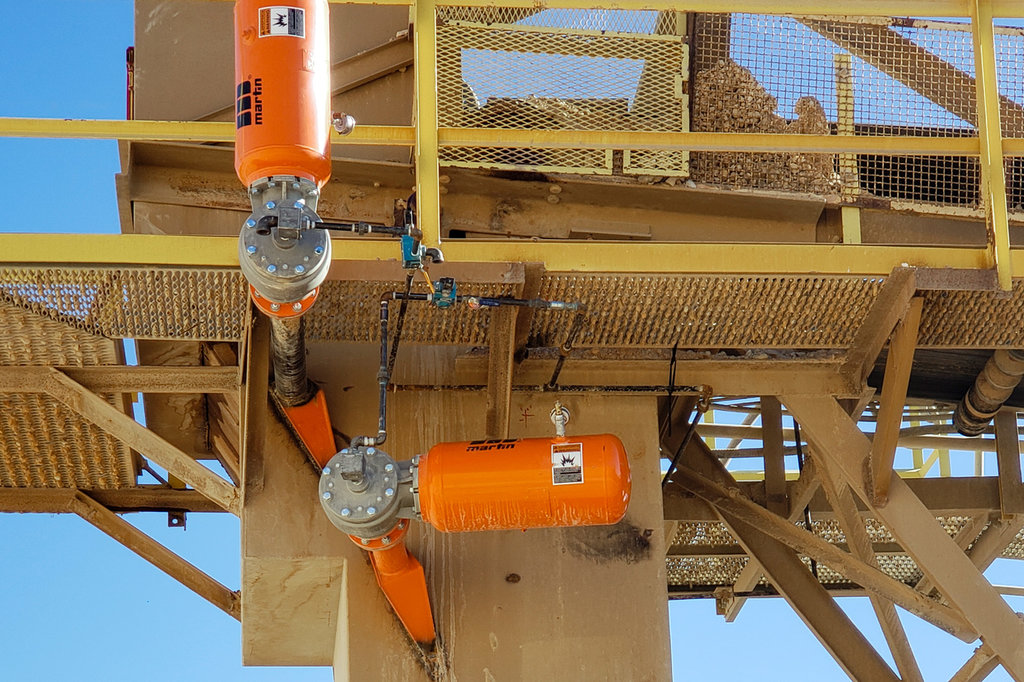Company Insight
Sponsored by Martin Engineering
Unblocking the Efficiency in Material Handling with Air Cannons
Standfirst
Martin Engineering’s Air Cannons are innovative devices designed to resolve material flow issues in various industries. Using compressed air, these cannons deliver powerful blasts to dislodge build-ups, blockages, or sticky materials within bins, silos, chutes, or hoppers. They ensure consistent material flow, preventing downtime and enhancing operational efficiency.
With a range of models catering to different needs, these cannons offer precise, targeted bursts, minimizing energy consumption and maximizing effectiveness. Renowned for their reliability, safety, and ability to tackle challenging material flow problems, Martin’s Air Cannons are a vital asset for industries dealing with bulk materials and production processes.
Composed by the following parts:
- Tank: A storage vessel for air. The bigger the tank, the longer the blast.
- Valve: The valve releases the stored air as quickly as possible; in about half a second your tank is empty.
- Nozzle: The nozzle shapes the air to effectively remove stuck material.
If dealing with common blockages, like the ones below, the environment and material characteristics will influence exactly how we approach the installation. There are many configurations and customizable aspects of applying air cannons to an operation.

Caption. Credit:
No matter the approach and configuration, air cannons are a viable solution to resolve clinging, arched, bridged, and rat-holed material. The flexibility of cannons allows you to have them fired by timers, downstream sensors, or manually when a problem is noticed.
In addition to the size of the air cannon, designers should vary the firing sequence to take into account the conditions of the chute, the materials being conveyed and the local climate.
Once an appropriate sequence is established, it can be programmed into an automated system so the system will not require attention from personnel.
Also, the number and distribution of air cannons in a chute depends on the types of materials and the design of the chute, but in general, one air cannon can usually keep an area clear between 1.5 and 2 square meters (15 to 20 square feet).
Air cannons with an air volume of 50 liters (1.75 cubic feet) have shown good results in chute applications, but these systems come in a variety of sizes, both in terms of air reservoir and discharge diameter.
A great option to upgrade your Transfer Point
An efficient transfer point is critical in material handling, since they ensure minimal spillage, reduced wear on equipment, and prevent blockages, optimizing the entire production process. Well-designed transfer points minimize dust emissions, enhancing safety and environmental compliance. By facilitating smooth material flow between conveyors, crushers, and stockpiles, efficient transfer points significantly boost productivity, enhance safety and lower maintenance costs.
Installing air cannons on transfer points is a strategic solution employed in bulk material handling systems to overcome common challenges associated with material flow. These transfer points often serve as critical junctions where materials change direction or transition between conveyors, and they are prone to blockages and material buildup.

Caption. Credit:
When placing an air cannon on a transfer chute, several crucial factors must be considered to ensure effective and safe operation: firstly, the location of the air cannon should be strategically chosen to target problem areas prone to material buildup or blockages. Secondly, the size and type of air cannon should match the specific requirements of the chute, with considerations for air pressure, flow rate, and nozzle design.
Don’t waste more time (and efficiency). Get in touch with us for more information about our Air Cannons.
Contact information
Martin Engineering Australia
www.martin-eng.com.au
mea@martin-eng.com
1300 627 364